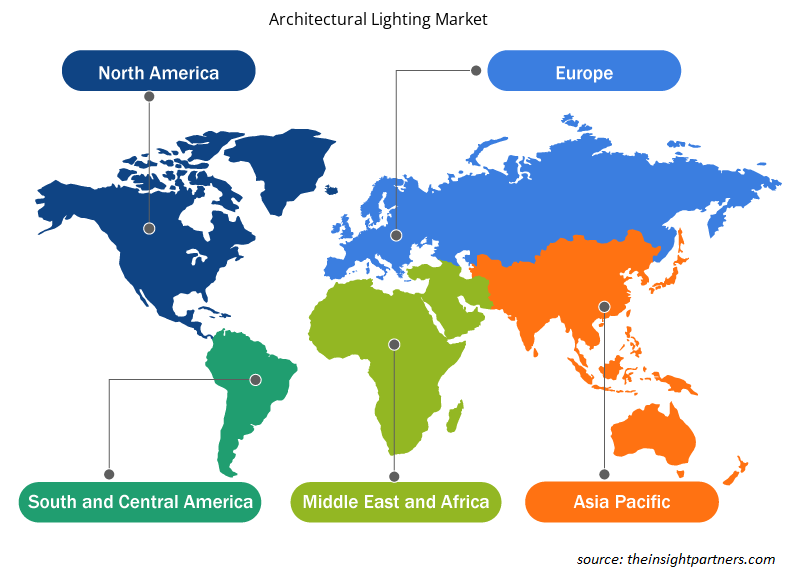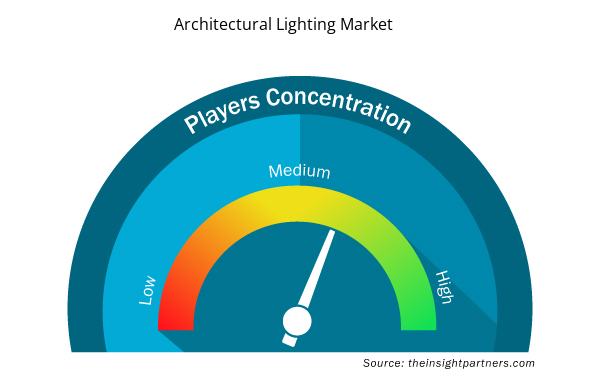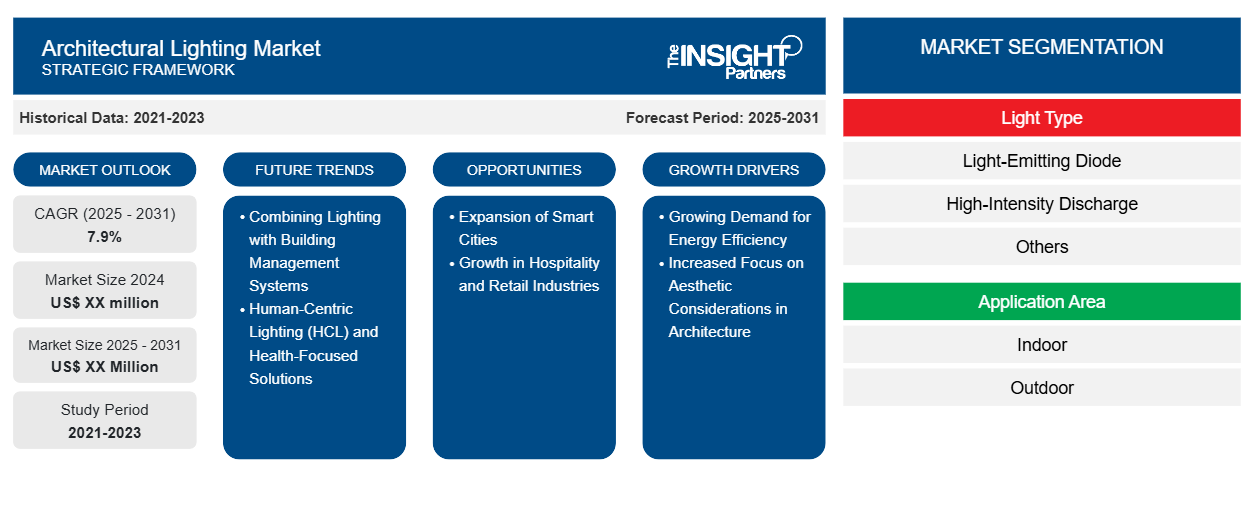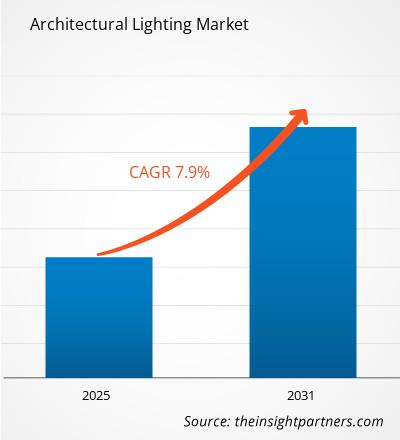Le marché de l'éclairage architectural devrait enregistrer un TCAC de 7,9 % de 2024 à 2031, avec une taille de marché passant de XX millions USD en 2024 à XX millions USD d'ici 2031.
Le rapport est segmenté par type d'éclairage (diode électroluminescente (LED), décharge à haute intensité (HID), autres), domaine d'application (intérieur, extérieur), utilisateur final (résidentiel, commercial). L'analyse mondiale est ensuite décomposée au niveau régional et par principaux pays. Le rapport offre la valeur en USD pour l'analyse et les segments ci-dessus
Objectif du rapport
Le rapport sur le marché de l'éclairage architectural de The Insight Partners vise à décrire le paysage actuel et la croissance future, les principaux facteurs moteurs, les défis et les opportunités. Cela fournira des informations à diverses parties prenantes commerciales, telles que :
- Fournisseurs/fabricants de technologie : pour comprendre l’évolution de la dynamique du marché et connaître les opportunités de croissance potentielles, leur permettant de prendre des décisions stratégiques éclairées.
- Investisseurs : Effectuer une analyse complète des tendances concernant le taux de croissance du marché, les projections financières du marché et les opportunités qui existent tout au long de la chaîne de valeur.
- Organismes de réglementation : Réglementer les politiques et surveiller les activités du marché dans le but de minimiser les abus, de préserver la confiance des investisseurs et de maintenir l’intégrité et la stabilité du marché.
Segmentation du marché de l'éclairage architectural
Type de lumière
- Diode électroluminescente
- Décharge à haute intensité
- Autres
Domaine d'application
- Intérieur
- De plein air
Utilisateur final
- Résidentiel
- Commercial
Géographie
- Amérique du Nord
- Europe
- Asie-Pacifique
- Amérique du Sud et Amérique centrale
- Moyen-Orient et Afrique
Personnalisez ce rapport en fonction de vos besoins
Vous bénéficierez d'une personnalisation gratuite de n'importe quel rapport, y compris de certaines parties de ce rapport, d'une analyse au niveau des pays, d'un pack de données Excel, ainsi que de superbes offres et réductions pour les start-ups et les universités.
- Obtenez les principales tendances clés du marché de ce rapport.Cet échantillon GRATUIT comprendra une analyse de données, allant des tendances du marché aux estimations et prévisions.
Facteurs de croissance du marché de l'éclairage architectural
- Demande croissante en matière d'efficacité énergétique : L'un des principaux facteurs de cette demande est l'attention accrue portée à la conception économe en énergie des bâtiments. Les solutions d'éclairage économes en énergie telles que la technologie LED ne consomment pas d'électricité mais permettent d'économiser de l'argent par rapport aux éclairages traditionnels. Elles peuvent donc être proposées aux consommateurs résidentiels et commerciaux.
- L'importance croissante accordée aux considérations esthétiques dans l'architecture : les marchés de l'éclairage architectural sont propulsés par l'importance croissante accordée à l'esthétique dans la conception architecturale. Grâce à des solutions d'éclairage innovantes, les architectes et les concepteurs peuvent créer des atmosphères distinctives et mettre en valeur les caractéristiques architecturales pour améliorer l'attrait visuel des bâtiments et des espaces.
Tendances futures du marché de l'éclairage architectural
- Associer l'éclairage aux systèmes de gestion des bâtiments : l'intégration de l'éclairage architectural aux systèmes de gestion des bâtiments est l'une des tendances émergentes. Une telle intégration permet un contrôle centralisé de l'éclairage en conjonction avec les systèmes CVC, de sécurité et autres pour améliorer la gestion de l'énergie et l'efficacité opérationnelle tout en offrant une expérience utilisateur transparente.
- L’éclairage centré sur l’humain (HCL) et les solutions axées sur la santé : une autre tendance importante sur le marché des systèmes d’éclairage et de contrôle intelligents est l’essor de l’éclairage centré sur l’humain (HCL), qui ajuste la température de couleur et la luminosité pour imiter la lumière naturelle du jour. Cette tendance est motivée par une prise de conscience croissante de l’impact de l’éclairage sur la santé, le bien-être et la productivité. Les systèmes HCL sont conçus pour soutenir les rythmes circadiens, améliorer la qualité du sommeil et renforcer la concentration et l’humeur dans différents environnements, notamment les maisons, les bureaux, les écoles et les établissements de santé. Grâce à davantage de recherches sur les effets de l’éclairage sur la santé, les solutions HCL deviennent un élément clé des systèmes d’éclairage intelligents résidentiels et commerciaux.
Opportunités du marché de l'éclairage architectural
- Expansion des villes intelligentes : L'expansion des initiatives de villes intelligentes offre de grandes opportunités au marché de l'éclairage architectural. Les systèmes d'éclairage intelligents dans les infrastructures urbaines peuvent être utilisés pour augmenter l'efficacité énergétique, renforcer la sécurité publique et fournir des données en temps réel pour la gestion de la ville, augmentant ainsi la demande de solutions d'éclairage innovantes.
- Croissance dans les secteurs de l'hôtellerie et de la vente au détail : La croissance dans les secteurs de l'hôtellerie et de la vente au détail ouvre des opportunités pour l'éclairage architectural. Des conceptions d'éclairage créatives et uniques peuvent permettre aux clients de vivre des atmosphères mémorables, ce qui incite les entreprises à investir dans des solutions d'éclairage avancées qui attirent et fidélisent les clients.
Aperçu régional du marché de l'éclairage architectural
Les tendances et facteurs régionaux influençant le marché de l’éclairage architectural tout au long de la période de prévision ont été expliqués en détail par les analystes d’Insight Partners. Cette section traite également des segments et de la géographie du marché de l’éclairage architectural en Amérique du Nord, en Europe, en Asie-Pacifique, au Moyen-Orient et en Afrique, ainsi qu’en Amérique du Sud et en Amérique centrale.

- Obtenez les données régionales spécifiques au marché de l'éclairage architectural
Portée du rapport sur le marché de l'éclairage architectural
| Attribut de rapport | Détails |
|---|---|
| Taille du marché en 2024 | XX millions de dollars américains |
| Taille du marché d'ici 2031 | XX millions de dollars américains |
| Taux de croissance annuel composé mondial (2025-2031) | 7,9% |
| Données historiques | 2021-2023 |
| Période de prévision | 2025-2031 |
| Segments couverts | Par type de lumière
|
| Régions et pays couverts | Amérique du Nord
|
| Leaders du marché et profils d'entreprises clés |
|
Densité des acteurs du marché de l'éclairage architectural : comprendre son impact sur la dynamique commerciale
Le marché de l'éclairage architectural connaît une croissance rapide, tirée par la demande croissante des utilisateurs finaux en raison de facteurs tels que l'évolution des préférences des consommateurs, les avancées technologiques et une plus grande sensibilisation aux avantages du produit. À mesure que la demande augmente, les entreprises élargissent leurs offres, innovent pour répondre aux besoins des consommateurs et capitalisent sur les tendances émergentes, ce qui alimente davantage la croissance du marché.
La densité des acteurs du marché fait référence à la répartition des entreprises ou des sociétés opérant sur un marché ou un secteur particulier. Elle indique le nombre de concurrents (acteurs du marché) présents sur un marché donné par rapport à sa taille ou à sa valeur marchande totale.
Les principales entreprises opérant sur le marché de l'éclairage architectural sont :
- ÉCLAIRAGE DE MARQUES ACUITY, INC.
- Lumière Delta
- GE Current, une société de Daintree
- Hubbell
- ORLIGHT LTÉE.
Avis de non-responsabilité : les sociétés répertoriées ci-dessus ne sont pas classées dans un ordre particulier.

- Obtenez un aperçu des principaux acteurs du marché de l'éclairage architectural
Principaux arguments de vente
- Couverture complète : Le rapport couvre de manière exhaustive l’analyse des produits, des services, des types et des utilisateurs finaux du marché de l’éclairage architectural, offrant un paysage holistique.
- Analyse d’experts : Le rapport est compilé sur la base d’une compréhension approfondie des experts et analystes du secteur.
- Informations à jour : Le rapport garantit la pertinence commerciale en raison de sa couverture des informations récentes et des tendances des données.
- Options de personnalisation : ce rapport peut être personnalisé pour répondre aux exigences spécifiques du client et s'adapter parfaitement aux stratégies commerciales.
Le rapport de recherche sur le marché de l’éclairage architectural peut donc aider à ouvrir la voie au décodage et à la compréhension du scénario de l’industrie et des perspectives de croissance. Bien qu’il puisse y avoir quelques préoccupations valables, les avantages globaux de ce rapport ont tendance à l’emporter sur les inconvénients.
- Analyse historique (2 ans), année de base, prévision (7 ans) avec TCAC
- Analyse PEST et SWO
- Taille du marché Valeur / Volume - Mondial, Régional, Pays
- Industrie et paysage concurrentiel
- Ensemble de données Excel


- Hand Sanitizer Market
- Asset Integrity Management Market
- Microcatheters Market
- Health Economics and Outcome Research (HEOR) Services Market
- Adaptive Traffic Control System Market
- Adaptive Traffic Control System Market
- Sodium Bicarbonate Market
- Medical Enzyme Technology Market
- Aircraft Landing Gear Market
- Advanced Planning and Scheduling Software Market

Report Coverage
Revenue forecast, Company Analysis, Industry landscape, Growth factors, and Trends

Segment Covered
This text is related
to segments covered.

Regional Scope
North America, Europe, Asia Pacific, Middle East & Africa, South & Central America

Country Scope
This text is related
to country scope.
Questions fréquemment posées
The report can be delivered in PDF/PPT format; we can also share excel dataset based on the request
Some of the customization options available based on the request are an additional 3-5 company profiles and country-specific analysis of 3-5 countries of your choice. Customizations are to be requested/discussed before making final order confirmation# as our team would review the same and check the feasibility
Combining Lighting with Building Management Systems
The Architectural Lighting Market is estimated to witness a CAGR of 7.9% from 2023 to 2037
Growing Demand for Energy Efficiency, Increased Focus on Aesthetic Considerations in Architecture
Trends and growth analysis reports related to Electronics and Semiconductor : READ MORE..
The List of Companies
1. ACUITY BRANDS LIGHTING, INC.
2. Delta Light
3. GE Current, a Daintree company
4. Hubbell
5. ORLIGHT LTD.
6. OSRAM GmbH
7. Siteco GmbH
8. Sylvania Lighting
9. Technical Consumer Products, Inc.
10. Zumtobel Group AG
The Insight Partners performs research in 4 major stages: Data Collection & Secondary Research, Primary Research, Data Analysis and Data Triangulation & Final Review.
- Data Collection and Secondary Research:
As a market research and consulting firm operating from a decade, we have published and advised several client across the globe. First step for any study will start with an assessment of currently available data and insights from existing reports. Further, historical and current market information is collected from Investor Presentations, Annual Reports, SEC Filings, etc., and other information related to company’s performance and market positioning are gathered from Paid Databases (Factiva, Hoovers, and Reuters) and various other publications available in public domain.
Several associations trade associates, technical forums, institutes, societies and organization are accessed to gain technical as well as market related insights through their publications such as research papers, blogs and press releases related to the studies are referred to get cues about the market. Further, white papers, journals, magazines, and other news articles published in last 3 years are scrutinized and analyzed to understand the current market trends.
- Primary Research:
The primarily interview analysis comprise of data obtained from industry participants interview and answers to survey questions gathered by in-house primary team.
For primary research, interviews are conducted with industry experts/CEOs/Marketing Managers/VPs/Subject Matter Experts from both demand and supply side to get a 360-degree view of the market. The primary team conducts several interviews based on the complexity of the markets to understand the various market trends and dynamics which makes research more credible and precise.
A typical research interview fulfils the following functions:
- Provides first-hand information on the market size, market trends, growth trends, competitive landscape, and outlook
- Validates and strengthens in-house secondary research findings
- Develops the analysis team’s expertise and market understanding
Primary research involves email interactions and telephone interviews for each market, category, segment, and sub-segment across geographies. The participants who typically take part in such a process include, but are not limited to:
- Industry participants: VPs, business development managers, market intelligence managers and national sales managers
- Outside experts: Valuation experts, research analysts and key opinion leaders specializing in the electronics and semiconductor industry.
Below is the breakup of our primary respondents by company, designation, and region:

Once we receive the confirmation from primary research sources or primary respondents, we finalize the base year market estimation and forecast the data as per the macroeconomic and microeconomic factors assessed during data collection.
- Data Analysis:
Once data is validated through both secondary as well as primary respondents, we finalize the market estimations by hypothesis formulation and factor analysis at regional and country level.
- Macro-Economic Factor Analysis:
We analyse macroeconomic indicators such the gross domestic product (GDP), increase in the demand for goods and services across industries, technological advancement, regional economic growth, governmental policies, the influence of COVID-19, PEST analysis, and other aspects. This analysis aids in setting benchmarks for various nations/regions and approximating market splits. Additionally, the general trend of the aforementioned components aid in determining the market's development possibilities.
- Country Level Data:
Various factors that are especially aligned to the country are taken into account to determine the market size for a certain area and country, including the presence of vendors, such as headquarters and offices, the country's GDP, demand patterns, and industry growth. To comprehend the market dynamics for the nation, a number of growth variables, inhibitors, application areas, and current market trends are researched. The aforementioned elements aid in determining the country's overall market's growth potential.
- Company Profile:
The “Table of Contents” is formulated by listing and analyzing more than 25 - 30 companies operating in the market ecosystem across geographies. However, we profile only 10 companies as a standard practice in our syndicate reports. These 10 companies comprise leading, emerging, and regional players. Nonetheless, our analysis is not restricted to the 10 listed companies, we also analyze other companies present in the market to develop a holistic view and understand the prevailing trends. The “Company Profiles” section in the report covers key facts, business description, products & services, financial information, SWOT analysis, and key developments. The financial information presented is extracted from the annual reports and official documents of the publicly listed companies. Upon collecting the information for the sections of respective companies, we verify them via various primary sources and then compile the data in respective company profiles. The company level information helps us in deriving the base number as well as in forecasting the market size.
- Developing Base Number:
Aggregation of sales statistics (2020-2022) and macro-economic factor, and other secondary and primary research insights are utilized to arrive at base number and related market shares for 2022. The data gaps are identified in this step and relevant market data is analyzed, collected from paid primary interviews or databases. On finalizing the base year market size, forecasts are developed on the basis of macro-economic, industry and market growth factors and company level analysis.
- Data Triangulation and Final Review:
The market findings and base year market size calculations are validated from supply as well as demand side. Demand side validations are based on macro-economic factor analysis and benchmarks for respective regions and countries. In case of supply side validations, revenues of major companies are estimated (in case not available) based on industry benchmark, approximate number of employees, product portfolio, and primary interviews revenues are gathered. Further revenue from target product/service segment is assessed to avoid overshooting of market statistics. In case of heavy deviations between supply and demand side values, all thes steps are repeated to achieve synchronization.
We follow an iterative model, wherein we share our research findings with Subject Matter Experts (SME’s) and Key Opinion Leaders (KOLs) until consensus view of the market is not formulated – this model negates any drastic deviation in the opinions of experts. Only validated and universally acceptable research findings are quoted in our reports.
We have important check points that we use to validate our research findings – which we call – data triangulation, where we validate the information, we generate from secondary sources with primary interviews and then we re-validate with our internal data bases and Subject matter experts. This comprehensive model enables us to deliver high quality, reliable data in shortest possible time.


 Obtenez un échantillon gratuit pour ce rapport
Obtenez un échantillon gratuit pour ce rapport